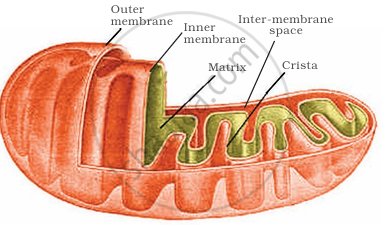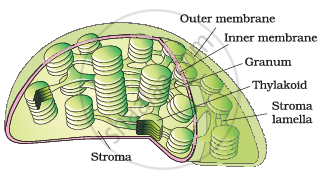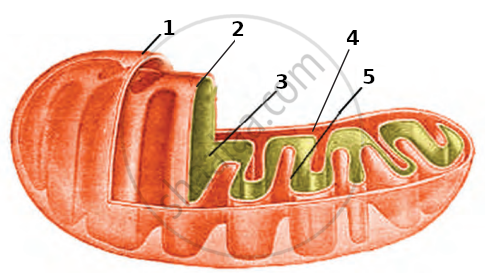Advertisements
Advertisements
Question
Name two cell-organelles that are double membrane bound. What are the characteristics of these two organelles? State their functions and draw labelled diagrams of both?
Solution
Mitochondria and chloroplasts are the two organelles that are double-membrane-bound.
Mitochondria:

Structure of mitochondrion (Longitudinal section)
- Characteristics of the mitochondria
- Mitochondria are double-membrane-bound structures. The membrane of a mitochondrion is divided into the inner and outer membranes, which are distinctly divided into two aqueous compartments: the outer and inner compartments.
- The outer membrane is very porous (containing the organelle), while the inner membrane is deeply-folded.
- These folds are known as cristae. Cristae increase the surface area inside the cell. They are the sites for ATP-generating chemical reactions. The membrane of a mitochondrion contains specific enzymes meant for specific mitochondrial functions. Hence, the mitochondria are the sites for aerobic respiration.
- They have their own DNA and ribosomes. Thus, they are able to make their own proteins. This is why they are considered as semi-autonomous organelles
- Functions of the mitochondria:
- They are the sites for cellular respiration.
- They provide energy in the form of ATP for all vital activities of living cells.
- They have their own DNA and ribosomes. Hence, they are regarded as semi-autonomous organelles.
- They have several enzymes, intermediately required for the synthesis of various chemicals such as fatty acids, steroids, and amino acids.
Chloroplasts:

Sectional view of chloroplast
- Characteristics of chloroplasts
- Chloroplasts are double-membrane-bound structures.
- They are divided into outer and inner membranes, further divided into two distinct regions:
- Grana are stacks of flattened discs containing chlorophyll molecules. The flattened membranous sacs are called thylakoids. Membranous tubules known as stroma lamellae link the thylakoids of neighbouring grana.
- Stroma is a homogenous mixture in which grana are embedded. It contains several enzymes that are used for the synthesis of carbohydrates and proteins. It also contains its own DNA and ribosomes.
- Functions of chloroplasts:
- They trap solar energy and use it to manufacture food for plants. Hence, they are involved in the process of photosynthesis.
- They contain the enzymes required for the synthesis of carbohydrates and proteins.
APPEARS IN
RELATED QUESTIONS
Given below is the diagram of animal cell. Select option giving correct identification of labels i and ii respectively.
Types of DNA present in matrix of mitochondria?
Select the incorrect statement regarding the given organelle:

Plastid differs from mitochondria on the basis of one of the following features. Mark the right answer.
Justify the statement, “Mitochondria are power houses of the cell”
